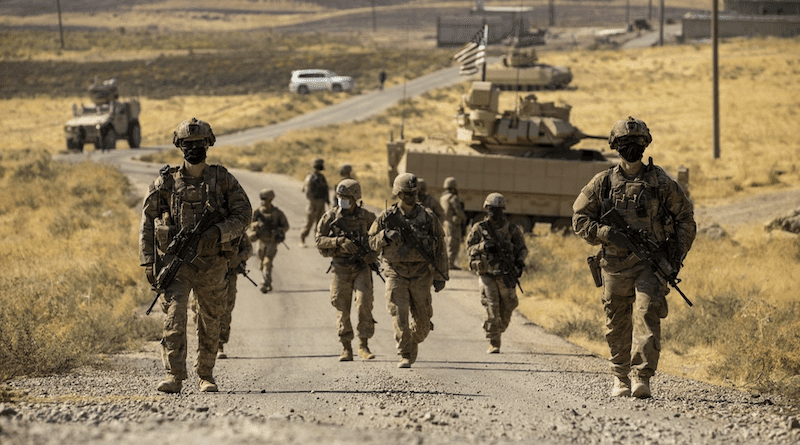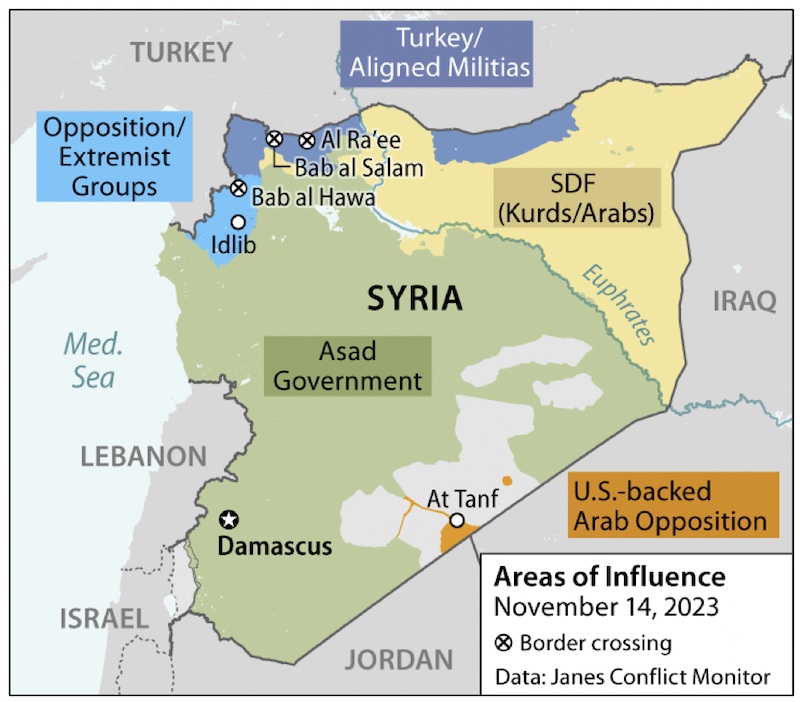Syria And US Policy – Analysis
By CRS
By Christopher M. Blanchard
Since 2011, conflict between the government of Syrian President Bashar al Asad and opposition forces seeking his removal has displaced roughly half of the country’s population and killed over half a million people. Five countries operate in or maintain military forces in Syria: Russia, Turkey (Türkiye), Iran, Israel, and the United States.
The United States supports a negotiated political settlement to the Syria conflict in accordance with U.N. Security Council Resolution 2254 and seeks the enduring defeat of the Islamic State (IS, aka ISIS/ISIL). U.S. policymakers work to address threats posed by IS remnants and detainees, counter Al Qaeda, facilitate humanitarian access to Syria, and manage Russian, Turkish, and Iranian challenges to U.S. operations.
Earthquakes in February 2023 and resurgent Russia-backed government attacks on rebel held areas of northwest Syria have created additional humanitarian needs. Following the October 2023 terrorist attacks in Israel and Israel’s military operations in Gaza, Iran-backed militia have attacked U.S. military personnel in Syria, prompting U.S. response strikes.
Areas of Control
The Asad Government
The Asad government—backed by Russia, Iran, and aligned Syrian and foreign militia forces—controls about two thirds of Syria’s territory, including most major cities. In 2021, President Asad won a fourth seven-year term; U.S. officials described the election as “an insult to democracy.” Some armed resistance to Asad’s rule remains, but the Arab League and some Arab states have normalized relations with the government and engage Asad and his senior officials directly.
Kurdish-Arab Military and Civilian Authorities
After the defeat of the Islamic State by the largely Kurdish U.S.-backed Syrian Democratic Forces (SDF), Kurdish authorities and their Arab partners in northeast Syria established the Autonomous Administration of North and East Syria (AANES), also known as the Self Administration of Northeast Syria (SANES). The SDF and its political wing (the Syrian Democratic Council, SDC) play a leading role in the AANES, whose leaders have stated that it is not aligned with either the Asad government or with opposition forces.
Turkey has clashed with the main Kurdish group within the SDF because of its links with the Kurdistan Workers’ Party (PKK), a U.S.-designated Foreign Terrorist Organization (FTO). Turkish strikes in Syria following an October 2023 PKK attack in Turkey damaged civilian infrastructure in areas under AANES control. Some Arab tribal forces have taken up arms against the SDF since August 2023, with reported Syrian government support.
Opposition and Extremist Forces
Opposition-held areas of northwest Syria are administered by the Syrian Salvation Government (SSG). The SSG was established in 2017 and is affiliated with Hayat Tahrir al Sham, which is an FTO due to its links to Al Qaeda. Many residents of this area have been displaced from areas of Syria now under Asad control, and an estimated 75% depend on U.N. assistance to meet their basic needs.
Turkish Forces and Aligned Militias
Turkish-held areas of northern Syria include territories occupied by Turkish forces in cooperation with Syrian Arab proxy forces. In these areas, Turkey has established local councils subordinate to the Turkish provinces they border, with Turkish provincial governments overseeing the provision of some basic services.
The Islamic State
U.S. military officials assess that the Islamic State operates as a cohesive, low-level insurgency, targeting Asad government forces in southwest Syria and the central Syrian desert, and the SDF in northern and eastern Syria.
Islamic State Detainees. The SDF continues to hold about 10,000 IS fighters in 26 detention facilities across northern Syria. In January 2022, U.S. forces joined SDF forces in a lengthy battle to retake a prison seized by IS fighters. The SDF also retains custody of up to 47,000 people linked to the Islamic State (mostly women and children) at the Al Hol IDP camp. U.S. officials assess that the Islamic State “views its fighters in detention and the population in the Al Hol displaced persons camp as keys to its resurgence.” In the Senate, the committee-reported FY2024 foreign aid appropriations bill (S. 2438) would direct $25 million to the Administration’s Al Hol Action Plan.
2023 Earthquakes
In February 2023, successive 7.8 and 7.5 magnitude earthquakes struck southern Turkey near the Syrian border, resulting in over 47,000 fatalities across both countries. Within Syria, the northwest—including areas controlled by opposition and extremist groups, and by Turkish-backed Syrian militia forces—was most impacted. The United States mobilized $251.5 million in humanitarian assistance to earthquake-affected populations in Syria in FY2023.
U.S. Policy
The Biden Administration identifies four policy priorities in pursuing a political settlement to the conflict as envisioned in Resolution 2254: (1) sustaining the U.S. and coalition campaign against the Islamic State; (2) supporting local ceasefires; (3) expanding humanitarian access; and (4) pressing for accountability and respect for international law while promoting human rights and nonproliferation, including through the imposition of targeted sanctions.
U.S. Military Presence: Operation Inherent Resolve
U.S. forces have operated inside Syria since 2015 pursuant to the 2001 and 2002 Authorizations for Use of Military Force (AUMF), amid ongoing debate in Congress about the authorization for U.S. operations in Syria. U.S. operations in Syria as part of Operation Inherent Resolve (OIR) seek “the enduring defeat of the ISIS.” About 800 U.S. troops are based in Syria to conduct counter-IS operations and support U.S. partner forces in pursuing their own counter-IS operations. Most U.S. forces are deployed in what military officials term the Eastern Syria Security Area, in support of the SDF. Some U.S. troops support the Syrian Free Army at the At Tanf garrison in south east Syria, which is located along a transit route between Iraq and Syria used by both IS fighters and by Iran-backed militias.
Since 2015, CENTCOM has conducted periodic military strikes in Syria outside the framework of OIR, including on targets linked to Al Qaeda, Syrian government chemical weapons-related targets, and Iran-backed militias—some of which have used Syria-based facilities to monitor and target U.S. forces in Syria and Iraq.
Since October 2023, the U.S. military has conducted strikes on facilities in eastern Syria associated with Iran’s Islamic Revolutionary Guard Corps and affiliated militias in response to attacks by Iran-backed militias on U.S. forces in Syria and Iraq. Strikes have targeted U.S. forces at At Tanf, near the Euphrates River valley, and in far northeast Syria.
U.S. Policy Tools
Syria Train and Equip Program
The Syria Train and Equip program, authorized by Congress in 2014 and funded via the Counter-ISIS Train and Equip Fund (CTEF), seeks to make partner forces in Syria capable of defeating the Islamic State. U.S. partner forces consist of the SDF and the SFA. U.S. military officials assess that the SDF “has the ability to successfully execute unilateral operations but relies on Coalition for some capabilities.” U.S. military officials assessed in June2023 that the SFA “primarily relies on Coalition support, including through CTEF, to carry out its mission to counter ISIS activities and provide Coalition force protection.”
FY2023 Funding and FY2024 Proposals. The FY2023 Consolidated Appropriations Act (P.L. 117-328 and accompanying explanatory statement) made $475 million available for CTEF, including $160 million for Syria. It also directed the rescission of $65 million in prior year CTEF funds. The President requests $156 million in FY2024 CTEF funds for Syria programs. The House-passed
defense appropriations bill (H.R. 4365) would provide the requested amount and recommends the rescission of $50 million in FY2023 appropriated funds, with the House Armed Services committee noting its concern about the accountability of funds allocated for partner force stipends in Syria. The Senate committee-reported version (S. 2587) would provide $146.2 million in FY2024 CTEF funds for Syria programs, and the Senate Armed Services Committee’s report expresses concern about the “makeshift” nature of some SDF-run detention facilities.
Sanctions
The United States maintains sanctions on Syria relating to its support for terrorism, interference in Lebanon, use of chemical weapons, and human rights violations. U.S. Department of the Treasury compliance guidance states that the United States “remains committed to ensuring that humanitarian assistance flows to the Syrian people.”
Humanitarian Assistance
The United States is the largest donor of humanitarian assistance to the Syria crisis, allocating nearly $17.2 billion since FY2012 for humanitarian efforts in Syria and in neighboring states that host Syrian refugees. In October 2023, U.N. officials estimate that more than 15 million Syrians required humanitarian or protection support.
Cross-Border Assistance. The Asad government in November 2023 extended permission to the United Nations to deliver cross-border aid to opposition held areas of northwest Syria using the Bab al Hawa and Al Ra’ee crossings until February 13, 2024. The U.N. Security Council had provided a mandate for cross-border aid with notification to (rather than the permission of) the Asad government from 2014 until July 2023, when Russia prevented the mandate’s reauthorization.
Stabilization Assistance
The United States has provided more than $1.3 billion in stabilization assistance for non-regime-held areas of Syria since 2011. The State Department describes stabilization assistance in northeast Syria as a counterweight to the influence of the Islamic State. The FY2023 Consolidated Appropriations Act (P.L. 117-328) provides funds under titles III and IV of Division K of the act “notwithstanding any other provision of law, for non-lethal stabilization assistance for Syria, including for emergency medical and rescue response and chemical weapons investigations.” The House-passed version of the FY2024 foreign assistance appropriations bill (H.R. 4665) would prohibit the use of funds made available by the act in Asad-controlled areas.
Issues for Congress
Congress may consider whether increased violence within Syria, more frequent attacks on U.S. forces in Syria, and developments in regional conflicts are affecting U.S. goals for Syria and whether or how U.S. military operations in Syria, Syria-related diplomacy, and/or humanitarian and stabilization operations should adapt. Congress may address Syria issues in foreign assistance and defense appropriations and authorization legislation for FY2024.
- About the author: Christopher M. Blanchard, Specialist in Middle Eastern Affairs
- Source: This article was published by the Congressional Research Service (CRS)


